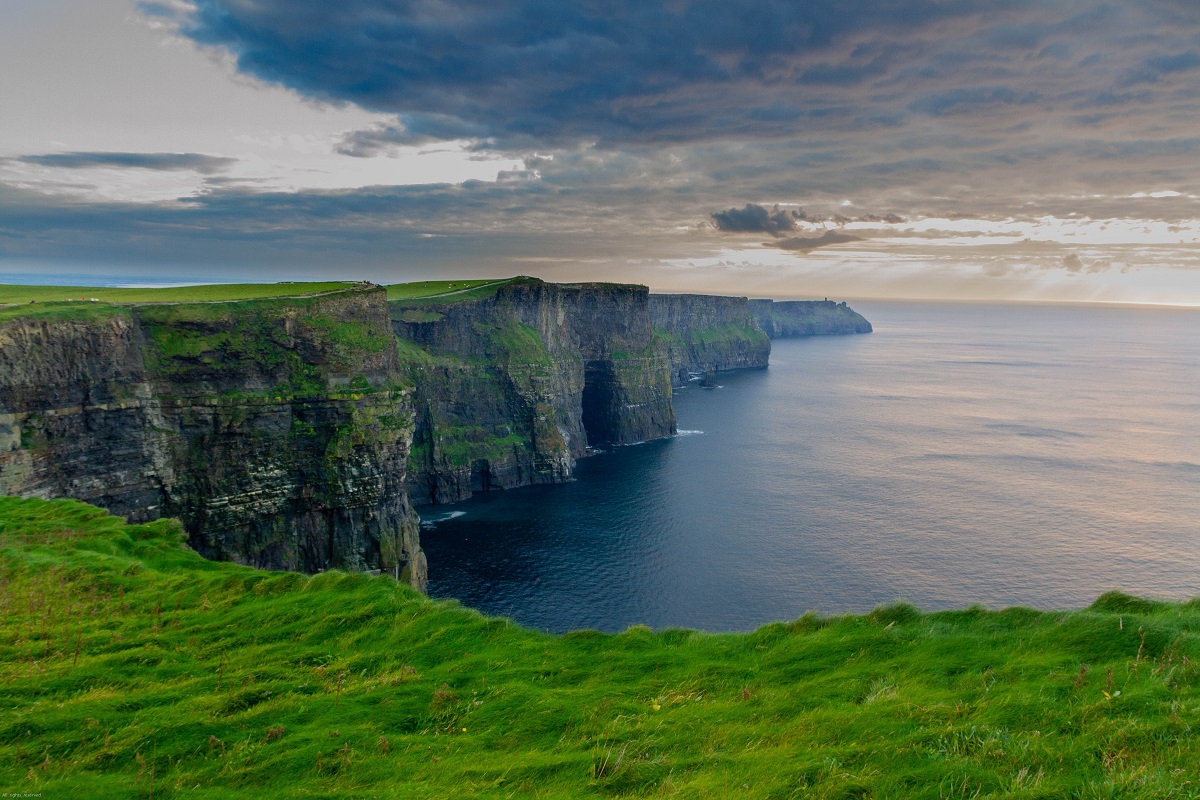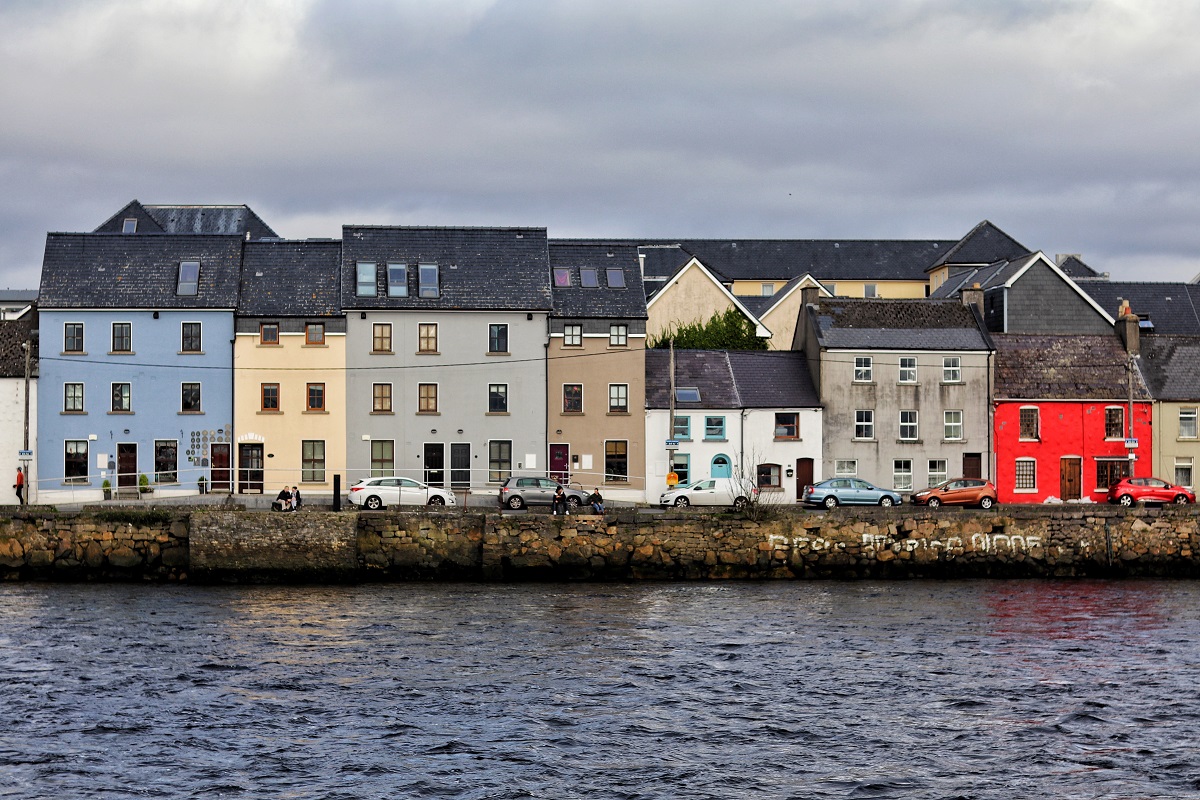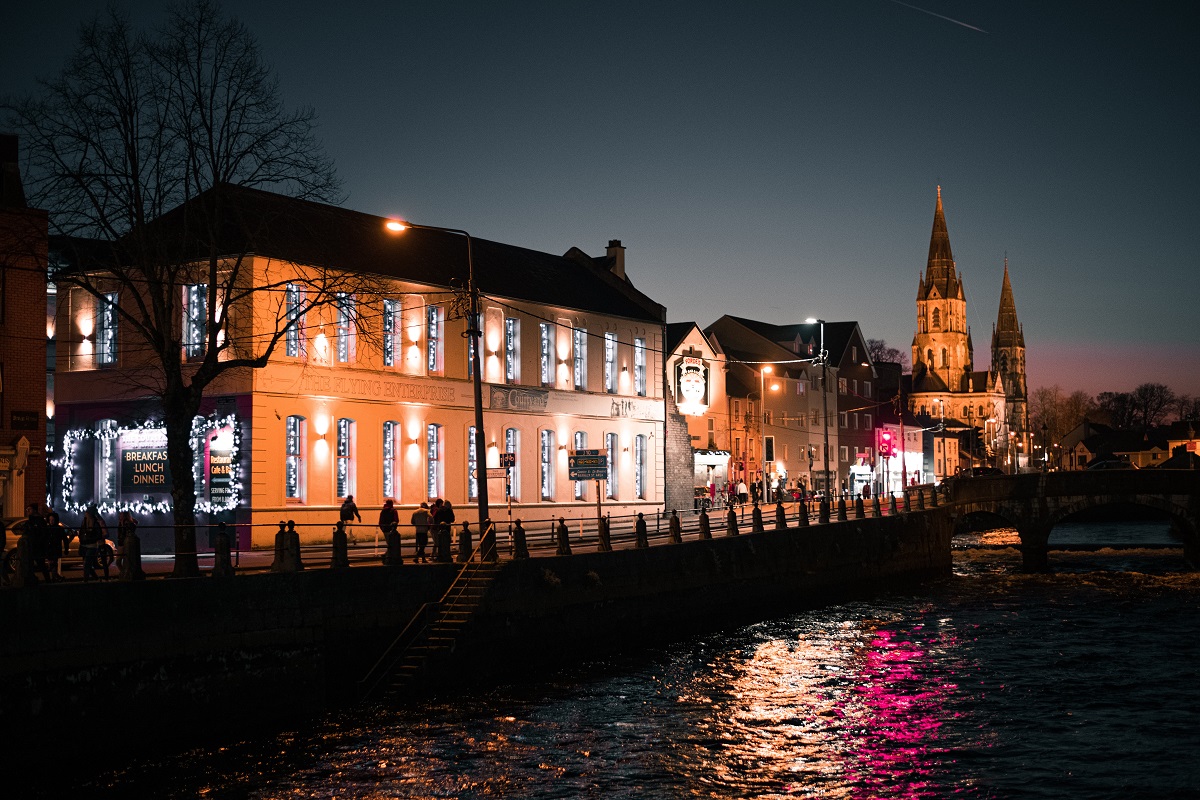Quick search
CTRL+K
Quick search
CTRL+K

Limerick is a beautifully situated town on the River Shannon, the longest river in Ireland and the British Isles. The city is the third largest in the Republic of Ireland and it is one of the cozy towns along the west coast of Ireland, where there are quite a few sights and a good atmosphere.
The Vikings founded the city, and the historic city center is located on King’s Island along both the Shannon River and the Abbey River. On King’s Island are i.a. the Englishtown district, where you can see the beautiful King John’s Castle and St Mary’s Cathedral.
The modern city center is located south of the Abbey River and has O’Connell Street as its main street. In this area you can also visit the Hunt Museum, which is one of the city’s interesting museums. You can also enjoy the green surroundings of the People’s Park and Georgian architecture in Pery Square.
The western city is surrounded by beautiful nature and interesting sights. Shannon’s estuary is located immediately west of the city, and both north and south of the river there is something to drive for. The world-famous Cliffs of Moher are to the northwest, and both Cork and Galway are within easy reach if you want to see other cities.
St. Mary’s Cathedral is an Anglican cathedral under the Church of Ireland. The church was founded in 1168, making it Limerick’s oldest building still in use. However, the decision to establish the cathedral was already taken at a synod in 1111.
It was Domnall Mór Ua Briain, who was the last king of Munster, who founded the construction of the cathedral on the site of his then palace on King’s Island. The palace went back to the historic area where the Vikings held their meetings in the city.
It is not known for sure, but parts of Domnall Mór Ua Briain’s palace may have been built into the church. It could, for example, be the western door, which may have been the main door in the otherwise historic royal palace. Incidentally, this door is part of the installation ritual of new bishops in Limerick.
Today you can see a beautiful and exciting church room with, among other things, glass mosaics in St. Mary’s Cathedral. Before entering, you can see the 36 meter high church tower, which was built in the 14th century.
King John’s Castle is a mighty 13th century castle located on King’s Island along the River Shannon. The castle area itself was established as a seat of government by the Vikings in the 9th century, but it was King John who in 1200 had the castle built, as you can see today.
The remains of the Viking earl Thormod Helgason’s settlement and seat from 922 were excavated in the 20th century. It was from here that the Vikings initially raided the areas along the Shannon, but they were defeated by other Vikings in 937 and 943, and the fighting continued through the centuries.
The arrival of the Anglo-Normans in 1172 changed the country. The Normans finally conquered the Limerick area in 1195, and already five years later King John started the construction of the castle, which is also called Limerick Castle, and which today is one of the best preserved Norman castles in Europe.
The castle was built on the Shannon to defend Limerick against Gaelic kingdoms to the west and against possible rebellions by Norman leaders from the east and south. The castle also came to function as the city’s security, and with the castle Limerick grew as a port city and trading centre.
The castle walls were partially destroyed during the Siege of Limerick in 1642, one of several sieges in the 17th century. However, the castle still stands as it did in its heyday, and in the years 2011-2013 the facility was renovated and a new visitor center was built, which provides an interesting presentation of the castle’s long history.
O’Connell Street is the name of Limerick’s main street. It was originally called George’s Street after King George III, before it was named after the Irish politician Daniel O’Connell, who, among other things, fought for the right of Catholics to sit in Parliament in Westminster in London.
The street is known for a number of buildings in Georgian architecture, which can also be seen to the south, where O’Connell Street ends in The Crescent and a monument to Daniel O’Connell. The street was also planned at the end of the 18th century and the beginning of the 19th century as a development of Limerick south of the medieval city.
The Crescent is an elongated and slightly curved square that is probably Limerick’s finest example of a unified ensemble of Georgian architecture. The place was originally called Richmond Place, but got its name from the built-up shape of the square.
In addition to the distinctive Georgian townhouses, you can see the Church of the Sacred Heart, originally built as a Jesuit church. In a smaller facility in the middle stands a monument to Daniel O’Connell, who was an important Irish political leader in the first half of the 19th century.
People’s Park is a beautiful city park located in the Newtown Pery area of central Limerick. In the 1830s, the park was intended as a green square with Georgian houses all around, but only Pery Square to the west was developed, and here today you can see one of the finest rows of Georgian houses in the city and the country.
The park in the middle was intended to be a kind of private garden, and the model was, among other things, Merrion Square in Dublin. Economic decline changed the plans, and instead People’s Park was dedicated in 1877 with, among other things, open lawns and a large monument to Thomas Spring Rice.
The land was granted to the city of Limerick for five hundred years with certain conditions. Thus, political and religious meetings were not allowed to take place in the park, and it was also a requirement that concerts were not allowed to take place on Sundays. Today, the park is a beautifully landscaped and popular recreational area.
Pery Square is an address in the Newtown Pery district of Limerick, where you can see fine examples of late Georgian architecture. The name Pery Square comes from the politician Edmund Sexton Pery, who was born in Limerick and who was Speaker of the Irish House of Commons from 1771 to 1785.
The row of houses from 1835-1838 at the south end of Pery Square is among the finest of its kind in Limerick and also in Ireland. It was architect James Pain who was probably behind the design of the row of houses, which were built by the Pery Square Tontine Company. With house number 2, one of the old houses stands as a kind of museum house, which is open for various events.
Hunt Museum is a museum located on the banks of the River Shannon. The museum exhibits the Hunt family’s art collection, which was donated for museum purposes to keep it together. You can see a varied collection of everything from effects from the Stone Age and ancient Egypt to works by, among others, Picasso.
The museum is located in the Custom House, which is one of the city’s finest Palladian-Georgian buildings from the 18th century. It was designed by the Italian Davis Ducart and built in limestone, unlike most of the other buildings from this part of the city, which were brick houses.
Limerick City Gallery of Art is an art gallery where you can not least enjoy Irish art from the 18th-19th centuries, which is shown as a permanent exhibition. You can also see changing exhibitions of contemporary art.
The museum building dates from 1906, when it was built as the Carnegie Library and Carnegie Museum in neo-Romanesque style. Since 1936, the current gallery, which is municipally run, has been located here.

The beautiful coastal cliffs along Ireland’s west coast are one of the island’s greatest attractions. The cliffs consist mostly of shale and sandstone, and they rise over 200 meters from the waves of the Atlantic Ocean. The most famous view is from the tower O’Brien’s Tower, which was built in 1835 by Cornelius O’Brien as a viewing tower for tourists of the time.
From the tower and the top of the cliffs there is a magnificent view, where you can see the archipelago of the Aran Islands to the west, Loop Head to the south and the mountains of Maumturks and Twelve Pins to the north. The name Cliffs of Moher derives from the now demolished Moher Fort, which stood on the site where the ruins of the Napoleonic era Moher Tower can be seen today.
The Cliffs of Moher Visitor Experience opened in 2007 and most visitors to the Cliffs start here. At the centre, the area’s geology, flora, fauna and history are communicated. However, you can also choose a number of other places and paths along the cliffs.

Galway is a cozy town on the west coast of Ireland, an area of magnificent scenery. You can enjoy lovely walks here and you can in the city of Galway too with its medieval streets, beautiful churches, colorful houses and much more that makes the trip memorable.
At the Galway Museum you can experience the history of the city, and from here you can easily walk around to the sights in the streets. The Latin Quarter with Kirwans Lane is a must during a visit where the lawns of Eyre Square and the houses along The Long Walk should be seen.

Cork is a city located in the south west of Ireland and is the second largest city in the Republic of Ireland. The city center is an island located between two arms of the River Lee. The river flows east and empties into Lough Mahon, which is part of Cork’s colossal natural harbor, where there are many lovely places for a trip outside the city.
In Cork there are many sights. You can see beautiful and impressive buildings such as the city hall and the courthouse. There are also many cozy places such as a walk along the River Lee or at the English Market.
Patrick Street
arthursquay.ie
Dooradoyle Road
crescentshoppingcentre.ie
Dublin Road
parkwaysc.com
O’Connell Street, Patrick Street
King John’s Castle
King’s Island
kingjohnscastle.com
Dreamland Fun Centre
Unit 6 Park Point, Dublin Road
dreamland.ie
Thomond Park Museum
Thomond Park
thomondpark.ie
Jurassic Parrr Mini-Golf
Delta Retail Park, Ballysimon
jurassicpar.ie
JumpLanes Trampoline Park
Kidstown 2, Unit 1, Delta Retail Park, Ballysimon Road
jumplanes.com
Foynes Flying Boat & Maritime Museum, Aras Ide, Foynes
flyingboatmuseum.com

Limerick, Ireland
Overview of Limerick
Limerick is a beautifully situated town on the River Shannon, the longest river in Ireland and the British Isles. The city is the third largest in the Republic of Ireland and it is one of the cozy towns along the west coast of Ireland, where there are quite a few sights and a good atmosphere.
The Vikings founded the city, and the historic city center is located on King’s Island along both the Shannon River and the Abbey River. On King’s Island are i.a. the Englishtown district, where you can see the beautiful King John’s Castle and St Mary’s Cathedral.
About the Whitehorse travel guide
Contents: Tours in the city + tours in the surrounding area
Published: Released soon
Author: Stig Albeck
Publisher: Vamados.com
Language: English
About the travel guide
The Whitehorse travel guide gives you an overview of the sights and activities of the Canadian city. Read about top sights and other sights, and get a tour guide with tour suggestions and detailed descriptions of all the city’s most important churches, monuments, mansions, museums, etc.
Whitehorse is waiting for you, and at vamados.com you can also find cheap flights and great deals on hotels for your trip. You just select your travel dates and then you get flight and accommodation suggestions in and around the city.
Read more about Whitehorse and Canada
Canada Travel Guide: https://vamados.com/canada
City tourism: https://visitwhite-horse.ca
Main Page: https://www.vamados.com/
Buy the travel guide
Click the “Add to Cart” button to purchase the travel guide. After that you will come to the payment, where you enter the purchase and payment information. Upon payment of the travel guide, you will immediately receive a receipt with a link to download your purchase. You can download the travel guide immediately or use the download link in the email later.
Use the travel guide
When you buy the travel guide to Whitehorse you get the book online so you can have it on your phone, tablet or computer – and of course you can choose to print it. Use the maps and tour suggestions and you will have a good and content-rich journey.

People’s Park is a beautiful city park located in the Newtown Pery area of central Limerick. In the 1830s, the park was intended as a green square with Georgian houses all around, but only Pery Square to the west was developed, and here today you can see one of the finest rows of Georgian houses in the city and the country.
The park in the middle was intended to be a kind of private garden, and the model was, among other things, Merrion Square in Dublin. Economic decline changed the plans, and instead People’s Park was dedicated in 1877 with, among other things, open lawns and a large monument to Thomas Spring Rice.
The land was granted to the city of Limerick for five hundred years with certain conditions. Thus, political and religious meetings were not allowed to take place in the park, and it was also a requirement that concerts were not allowed to take place on Sundays. Today, the park is a beautifully landscaped and popular recreational area.
Pery Square is an address in the Newtown Pery district of Limerick, where you can see fine examples of late Georgian architecture. The name Pery Square comes from the politician Edmund Sexton Pery, who was born in Limerick and who was Speaker of the Irish House of Commons from 1771 to 1785.
The row of houses from 1835-1838 at the south end of Pery Square is among the finest of its kind in Limerick and also in Ireland. It was architect James Pain who was probably behind the design of the row of houses, which were built by the Pery Square Tontine Company. With house number 2, one of the old houses stands as a kind of museum house, which is open for various events.
Hunt Museum is a museum located on the banks of the River Shannon. The museum exhibits the Hunt family’s art collection, which was donated for museum purposes to keep it together. You can see a varied collection of everything from effects from the Stone Age and ancient Egypt to works by, among others, Picasso.
The museum is located in the Custom House, which is one of the city’s finest Palladian-Georgian buildings from the 18th century. It was designed by the Italian Davis Ducart and built in limestone, unlike most of the other buildings from this part of the city, which were brick houses.
Limerick City Gallery of Art is an art gallery where you can not least enjoy Irish art from the 18th-19th centuries, which is shown as a permanent exhibition. You can also see changing exhibitions of contemporary art.
The museum building dates from 1906, when it was built as the Carnegie Library and Carnegie Museum in neo-Romanesque style. Since 1936, the current gallery, which is municipally run, has been located here.
Similar to Limerick Travel Guide
